Gravesend and Northfleet Electric Tramways
History
Powers to convert the existing 3ft 6ins-gauge horse tramway — operated by the Gravesend, Rosherville and Northfleet Tramways Company — to standard gauge and overhead electric traction, were granted in late 1899 by the Gravesend, Rosherville and Northfleet Tramways Order, which was authorised under the umbrella of the Tramways Orders Confirmation (No. 3) Act, 1899. The promoter was the Drake and Gorham Electric Power and Traction Syndicate, which had recently gained a controlling interest in the horse tramway.
Around this time, the D&GEP&TS changed its name to the National Electric Traction Company, in which guise it would be involved in the promotion of several electric tramway schemes; it did not, however, ever operate a tramway itself, often acquiring powers, then either selling them on or letting them lapse. In the case of its Gravesend scheme, the NETCo, having acquired the requisite powers for a new electric system, sold these, as well as its stake in the GR&NTCo, to the British Electric Traction Company (BETCo), the latter taking over on the 1st January 1901.
During the late 1890s and early 1900s, the BETCo was embarking on a journey that would see it become a major player in the tramway world. It began by purchasing horse and steam-operated tramways across the British Isles with the intention of converting them to electric traction, as well as promoting schemes for completely new electric tramways, and was destined to own, part-own or lease over 50 tramway concerns across the United Kingdom.
With electrification looming, the GR&NTCo's name was changed — on the 18th April 1901 — to Gravesend and Northfleet Electric Tramways Limited. The horse trams continued to operate until the 30th June 1901, at which point the tramway was closed to enable its conversion to overhead electric traction.
The new electric services commenced operating on the 2nd August 1902 between the 'Leather Bottel' pub in Northfleet and the Clock Tower in Gravesend. The remaining sections were opened on the 22nd September (Denton, Swanscombe, and Pelham Road), the 30th January 1903 (Dover Road), and finally, on the 4th December 1903, the Windmill Street branch. This took the standard-gauge system to its final size of 6.47 miles. The main line ran from a terminus in London Road, Swanscombe (close to Craylands Lane) eastwards, roughly paralleling the River Thames — via Northfleet High Street, the 'Leather Bottel' pub, London Road, Overcliffe Road, and New Road to Gravesend, continuing eastwards via King Street — to its eastern terminus in Milton Road, Denton. At the 'Leather Bottel', a line branched off southeastwards along Dover Road and Old Road, to the Pelham Arms, where it turned northeastwards, returning to the main line via Pelham Road. In addition, there was a short branch from Gravesend town centre along Windmill Street to a terminus adjacent to the Old Prince of Orange Inn. Although there was much talk of connecting the system to that of Dartford Council's at Horns Cross, circa 1.5 miles to the west of Swanscombe, the gap was never closed.
The services were initially worked by 20 tramcars, half of them large bogie vehicles. Unfortunately, passenger numbers were far short of those anticipated, particularly along the Dover Road route, the company quickly divesting itself of the expensive bogie trams — to other BETCo systems — and replacing them with smaller vehicles more suited to its needs.
The company branched out into motorbus operation in 1913, introducing services to Chatham in the east, and to Dartford in the west, the latter much to Dartford Council's chagrin, as it had only recently gone to the expense (in 1912) of acquiring powers to build a tramway linking the two systems. The services were operated by a subsidiary, North Kent Motor Services, which by 1915 had 17 vehicles, several of them being requisitioned by the military, with obvious consequences for the services provided. The Great War also brought significant pressures to the tramway through loss of men (and their skills), severe restrictions on spares and materials, and increased passenger numbers. By the end of the conflict, the tramway, having suffered four years of sparse maintenance, was in fairly run-down condition, and was losing money.
On the 15th March 1920, the company's motorbus subsidiary — North Kent Motor Services — was sold to Maidstone and District Motor Services, which was also a BETCo subsidiary, the G&NETL receiving shares in that company. The tramway was much criticised locally for the state of the tramcars and track, so it was no surprise, with the system making a loss, that the company floated the idea of closing it, a move that was opposed by the local councils. Rather than attempting to drive this through against municipal opposition, the company endeavoured to put the tramway in order, overhauling several tramcars, fitting top-covers to six of them, and acquiring two second-hand vehicles. Additionally, the track on the main line between St James Church (Gravesend) and the 'Leather Bottel' was completely renewed in 1921. The expense incurred was to some extent offset by an increase in fares, which the company had obtained parliamentary sanction for on the 4th August 1920 via the Gravesend, Rosherville and Northfleet Tramways (Amendment) Order, which passed into law under the Tramways Orders Confirmation Act, 1920.
Although the tramway struggled on, things only got worse from the mid 1920s onwards, services being subjected to intense competition from independent motorbus operators. The tramway, with its old tramcars and decrepit track, was clearly on borrowed time, and in 1928, the company obtained powers to replace the tramway with motorbus services. As a prelude to this, the tramway was taken over by Maidstone and District Motor Services (in January 1929), the last tram running barely a month later on the 28th February 1929, the new services being provided by a fleet of 16 double-deck motorbuses.
Uniforms
The photographs below show Gravesend tramway crews wearing the familiar and largely regulation BETCo uniform. Although jackets appeared to vary somewhat between BETCo systems, as well as across the decades, the cap badges, collar designations and buttons invariably followed a standard pattern.
The first uniform jackets were double-breasted, with four pairs of buttons (of the standard BETCo pattern — see link) and lapels, conferring a vaguely naval appearance on the wearer; the collars carried embroidered system initials on both sides ('G & N. E. T’). The soft-topped, peaked caps carried a standard brass BETCo ‘Magnet & Wheel’ cap badge (see below), worn above an employee number (in individual brass numerals). Several photographs have, however, survived that show staff wearing their employee numbers either side of the 'Magnet & Wheel' cap badge, an affectation unique to this system; this would of course not have been possible for employees with single-digit numbers.
The naval-style jackets seem only to have lasted a short time before being superseded. Motormen were subsequently issued with double-breasted, lancer-style tunics with five pairs of buttons (narrowing from top to bottom) and stand-up collars; the latter carried individual initials on the right-hand side, probably either ’G & N E T’ or ‘G & N T’ and an employee number on the left, all presumably brass to match the buttons. Although photographs exist which show conductors wearing the same style of tunics as those issued to motormen, the majority show them in single-breasted jackets with five buttons, a single breast pocket, and stand-up collars. The soft-topped peaked caps were also quickly replaced, being superseded by tensioned-crown, peaked caps, the latter's crown being flat rather than convex.
Tramcar crews were also issued with double-breasted greatcoats with three waist/hip-level pockets, lapels and epaulettes; these garments do not appear to have borne any insignia.
Inspectors wore single-breasted jackets with hidden buttons (or more likely a hook and eye affair) and stand-up collars, all edged in a finer material than the main body of the jacket; the collars almost certainly bore the grade — 'Inspector' — in embroidered script lettering. The standard ‘Magnet & Wheel’ cap badge was worn on the cap, along with an embroidered script-lettering 'Inspector' badge on a hat band.
In common with the majority of UK tramway systems, Gravesend employed women during the Great War — both as conductresses and motorwomen — to replace male staff lost to the armed forces. Unfortunately, photographs appear not to have survived, so it is currently impossible to say what uniforms, if any, were issued to these ladies, though in all probability they would have been similar to those used on the vast majority of BETCo tramways.
Further reading
For a history of Gravesend's Tramways, see: 'The Tramways of Kent - Volume 1, West Kent' by Invicta; The Light Railway Transport League (1971).
Images
Motormen and conductors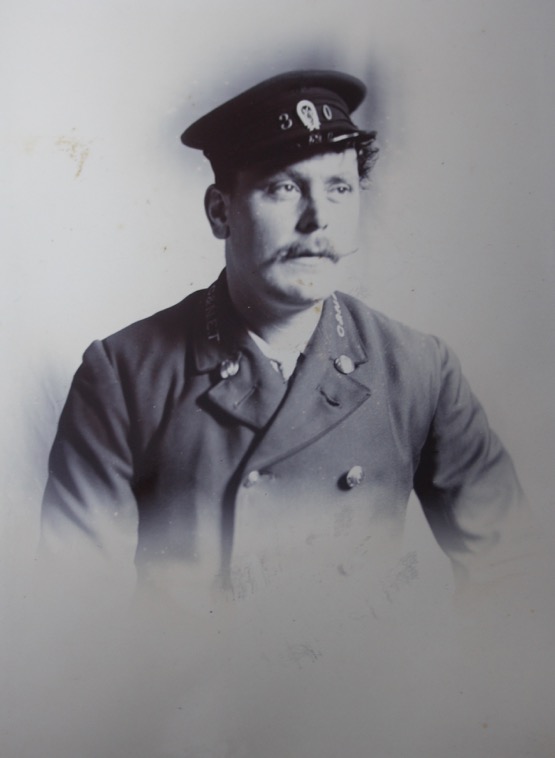
An excellent studio portrait of a Gravesend and Northfleet Electric Tramways employee (No 30) — photo undated, but probably taken around the time of opening (1902). Photo by kind permission of Linda Reed.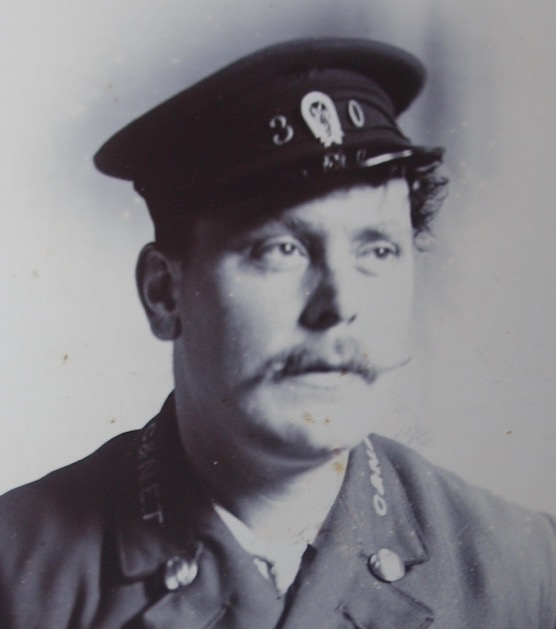
An enlargement of the above photograph showing the collar insignia — embroidered 'G & N. E. T' block initials — and the standard BETCo 'Magnet & Wheel' cap badge. Wearing the employee numbers either side of the cap badge was certainly not standard BETCo practice (they were normally worn below the main badge), an affectation that clearly would not have worked for the first nine employees!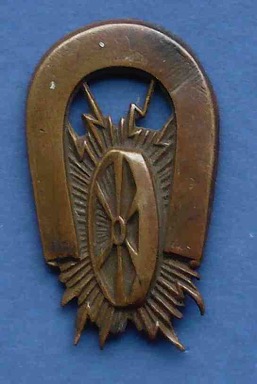
Standard BETCo ‘Magnet & Wheel’ cap badge — brass, as worn by Gravesend tramway crews. Author's Collection.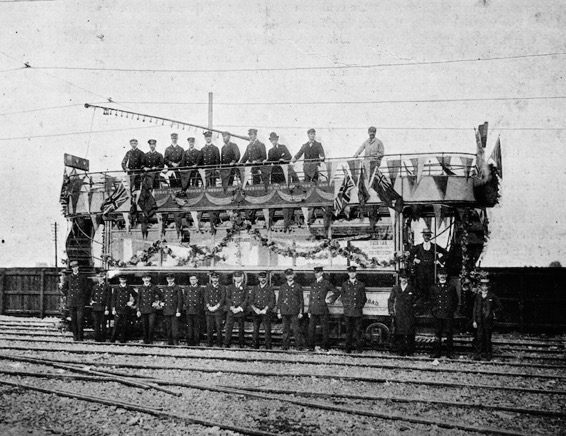
A scene taken in the depot yard at Dover Road with one of the original 1-10 series cars (disposed of by 1906) — photo believed to have been taken in 1903, possibly on the occasion of Gravesend Carnival. Photo courtesy of the National Tramway Museum. 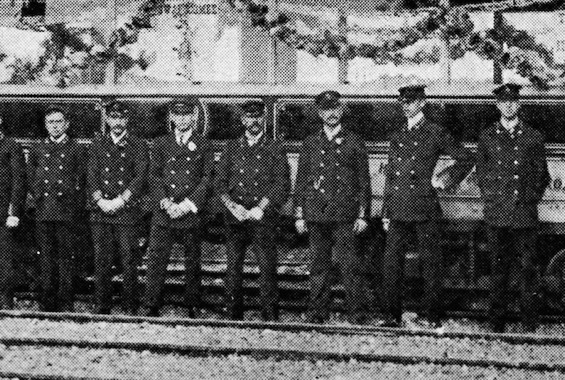
An enlargement of the above photograph, which though of poor quality, does show that tramcar staff wore double-breasted jackets with soft-topped, peaked caps.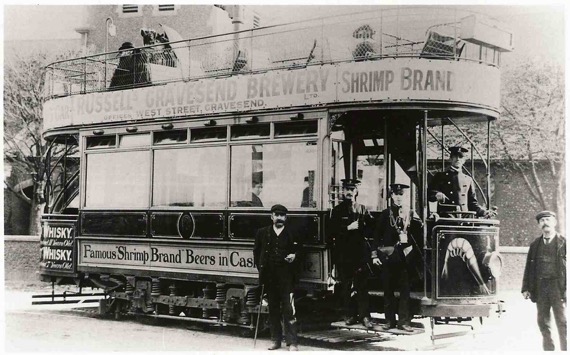
A view of Gravesend’s famous ’shrimp’ car (Tramcar No 1) — photo undated, but probably taken just before the advent of the Great War. The tramcar advertised Russell’s ‘Shrimp Brand’ Brewery, being extensively adorned with promotional material (inside and out), including a large shrimp on the dash! The view shows an inspector (second left), a conductor (third left) and a motorman (fourth left). With thanks to Richard Rosa.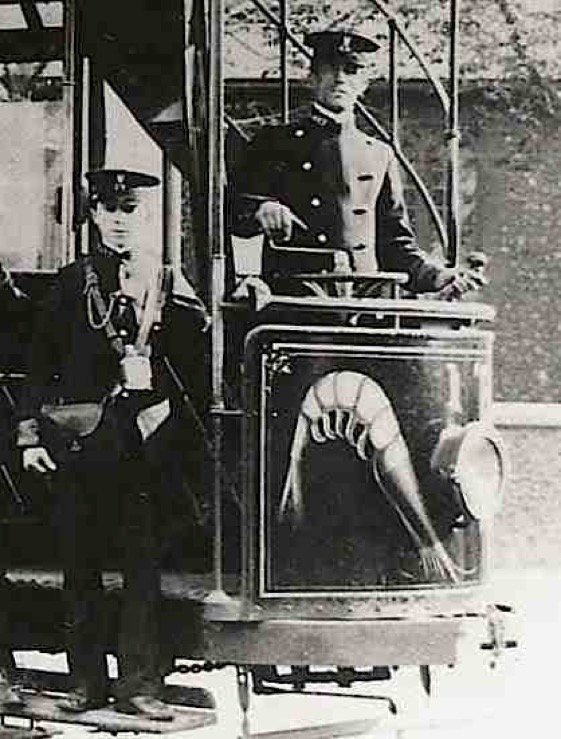
An enlargement of the above photograph showing details of the crew's uniforms. Both men are wearing the standard BETCo 'Magnet & Wheel' cap badge, with their employee numbers mounted below, on tensioned-crown peaked caps. The collar badges appear to be a mixture of 'G&NT' and 'G&NET’.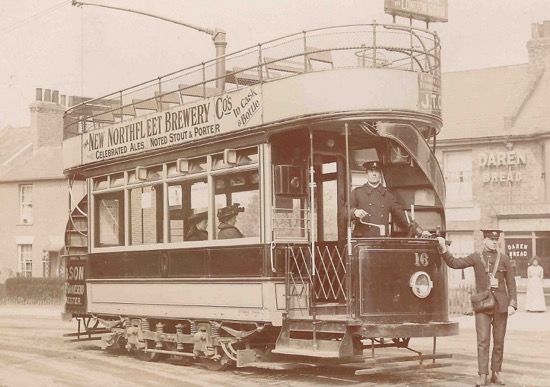
A motorman and a conductor pose with Tramcar No 16 — photo undated, but certainly taken before 1924/5 when this car was fitted with a top cover. With thanks to Richard Rosa.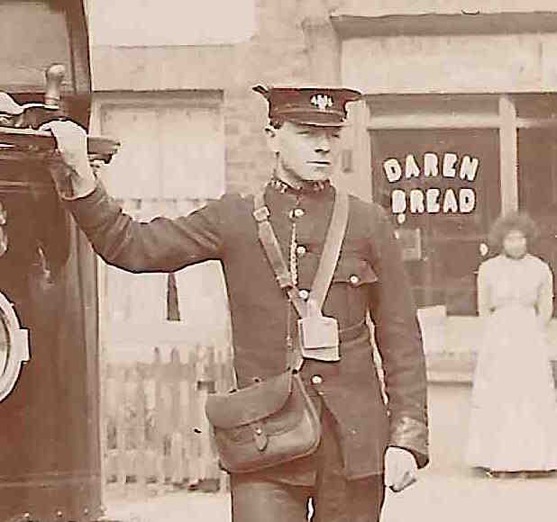
An enlargement of the above photograph showing the conductor, who appears to be wearing a regimental cap badge (common practice during and after the Great War) flanked by the digits of his employee number (possibly 44).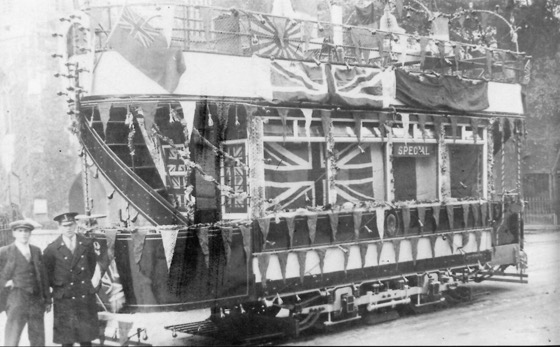
A G&NET motorman poses with decorated Tramcar No 2 on the occasion of Gravesend Carnival in 1927. Photo courtesy of the Tramways and Light Railway Society, with thanks to David Voice.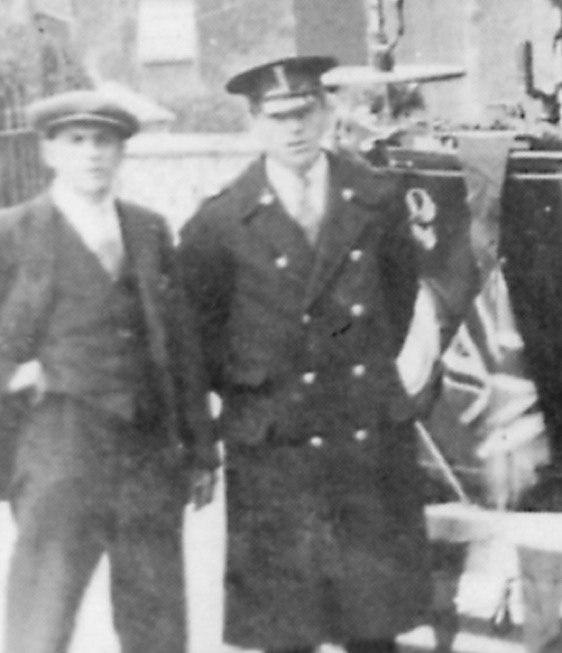
An enlargement of the above photograph showing the motorman, in his double-breasted greatcoat.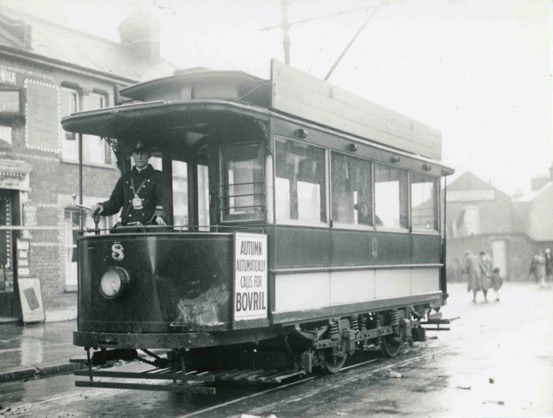
G&NET No 8 and motorman captured on October 1928. Photo courtesy of the National Tramway Museum. 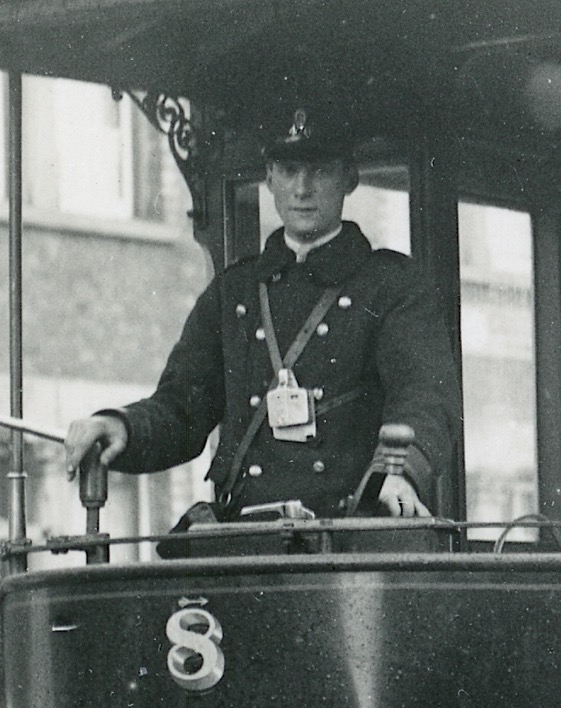
An enlargement of the above photograph showing the motorman, who is possibly Employee No 40.
Senior staff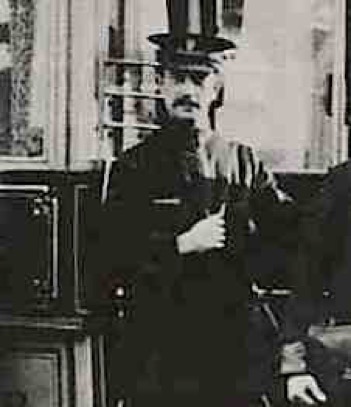
An enlargement of the 'Shrimp Car' photograph above, showing the inspector. He is wearing a 'Magnet & Wheel' cap badge above an embroidered, script-lettering grade badge.